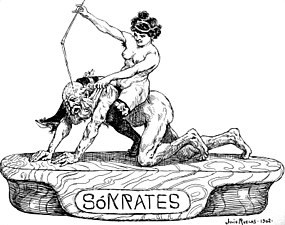Phyllis and Aristotle


The tale of Phyllis and Aristotle is a medieval cautionary tale about the triumph of a seductive woman, Phyllis, over the greatest male intellect, the ancient Greek philosopher Aristotle. It is one of several Power of Women stories from that time. Among early versions is the French Lai d'Aristote from 1220.
The story of the dominatrix and the famous intellectual was taken up by artists from the 12th century onwards, in media from stone sculpture in churches to panels of wood or ivory, textiles such as carpets and tapestries, engravings, oil paintings, brass jugs (aquamanile), and stained glass. Artists attracted to the theme include Hans Baldung, Albrecht Dürer, Lucas Cranach the Elder, and Alessandro Turchi.
Story
[edit]The tale varies in the telling, but the core of it is as follows: Aristotle advises his pupil Alexander to avoid Phyllis, the seductive mistress of his father, the king, but is himself captivated by her. She agrees to ride him, on condition that she play the role of dominatrix. Phyllis has secretly told Alexander what to expect, and he witnesses Phyllis proving that a woman's charms can overcome even the greatest philosopher's male intellect. Phyllis is also described as Alexander's mistress or possibly wife, rather than his father's.[1][2][3]
Origins
[edit]The entirely invented story is said by the Louvre to derive from the German work by Jacques de Vitry in the 13th century.[4][5] The French work Le Lai d'Aristote (The Lay of Aristotle) is known from manuscripts dating from as early as 1220, attributed by scholars to either Henri d'Andeli or Henri de Valenciennes.[6][7][a]
In 1386, the English poet John Gower included a summary of the tale in his Confessio Amantis (in English, unlike his other major works), a collection of stories of immoral love told in verse. It appears in the poem on Apollonius of Tyre (Book 8, 271–2018), where Gower quips that the philosopher's logic and syllogisms do not save him:[9]
- I syh there Aristotle also,
- Whom that the queene of Grece so
- Hath bridled, that in thilke time
- Sche made him such a Silogime,
- That he foryat al his logique;
- Ther was non art of his Practique,
- Thurgh which it mihte ben excluded
- That he ne was fully concluded
- To love, and dede his obeissance
Also in the 14th century, the Dominican John Herold wrote a Latin version of the story.[10][11]
In the 15th century, it was featured in the German comedy Ain Spil van Maister Aristotiles (A play of Master Aristotle).[4][12]
Analysis
[edit]| Story element | Lai d'Aristote – French[13] | Aristoteles und Phyllis – German[14] |
|---|---|---|
| Alexander | is a victorious king, conqueror of India | is a young man in his father's court |
| The young woman | is just called "the Indian" | is Phyllis, of noble birth, in the queen's entourage |
| Situation: Alexander | is lectured by Aristotle for neglecting his duty as head of state and the army | ignores the king's order not to see his lover, as requested by Aristotle for not concentrating on his lessons |
| The young woman | decides to get revenge on the philosopher | decides to get revenge on the philosopher |
| The contract: Aristotle | promises he will speak to Alexander on her behalf, in return for her favours | asks her to spend the night with him, in return for money |
| The seduction scene | takes place in a garden | takes place in a garden |
| She rides on Aristotle's back | observed by a laughing Alexander | observed by the queen and her retinue, and Phyllis roundly insults Aristotle |
| In the end, Aristotle | excuses himself to Alexander, saying Amour vainc tot, et tot vaincra tant com li monde durera (Love conquers all, and all shall conquer As long as the world shall last) | flees to a far country, where he meditates on the wickedness of feminine wiles. |
Illustrations
[edit]Medieval
[edit]The cautionary tale of the dominatrix who made a fool of the famous philosopher became popular across medieval Europe.[2] Medieval sculptors in Maasland created aquamanile, jugs in the forms of scenes with human or other figures, depicting Phyllis and Aristotle. The story was depicted in a variety of media including stone, ivory, brass, carpet, tapestry, and engravings.
- Stone sculpture, Cadouin Abbey, France, 12th century
- Panel of casket with scenes of romances, France, ivory, 1330–1350
- Carpet, Freiburg, Germany, 14th century
- Aquamanile in the form of Phyllis and Aristotle, prob. Maasland, 1400–1450, brass
- Phyllis riding and slapping Aristotle, Aquamanile, Maasland, c. 1400, brass
- Detail of tapestry, Basel, 1470s
Early Modern to Enlightenment
[edit]Artists such as Hans Baldung,[b] Albrecht Dürer, Lucas Cranach the Elder, Bartholomeus Spranger and Jan Sadeler continued to exploit the theme, eventually with Phyllis entirely naked.[4] Alessandro Turchi called the woman Campaspe, the mistress of Alexander. The media used include engraving, stained glass, wood, and oil painting.
- Drypoint of Aristotle ridden by Phyllis by the Housebook Master. c. 1490
- Engraving, Lucas van Leyden, c. 1520
- Stained glass, Germany, c. 1520
- Detail of a Power of Women decoration meant for Nuremberg Town Hall, Albrecht Dürer, 1521
- Aristotle and Phyllis, the Master of Ottobeuren, wood, 1523
- Phyllis and Aristotle, Lucas Cranach the Elder, oil on panel, 1530
- Phyllis and Aristotle, Jan Sadeler after Bartholomeus Spranger, engraving, 16th century
- Aristotle and Campaspe, Alessandro Turchi (attrib.) Oil on canvas, 1713
Nineteenth and twentieth centuries
[edit]Artists such as Julio Ruelas continued to adapt the Phyllis and Aristotle theme. Oscar Kokoschka produced a version in 1913.[15]
- Le Char (The Chariot), poster by Edward Ancourt for opera by Émile Pessard, 1878
- Sokrates, Julio Ruelas (1870–1907), 1902. The woman wears modern stockings and shoes
See also
[edit]Notes
[edit]References
[edit]- ^ "Aristotle and Phyllis". Art Institute of Chicago. Retrieved 22 March 2018.
- ^ a b Smith, Justin E. H. (2 April 2013). "Phyllis Rides Aristotle". Justin E. H. Smith. Retrieved 31 March 2018.
- ^ "Aristotle Plays Horsey and Other Strange Tales". Classical Wisdom Weekly. 10 March 2014. Retrieved 31 March 2018.
- ^ a b c "Phyllis and Aristotle | The Triumph of Seduction over Intellect". Louvre. Retrieved 22 March 2018.
- ^ "Object Lesson: Did Aristotle Really Humiliate Himself for Phyllis?". The National Endowment for the Humanities. Retrieved 13 August 2023.
- ^ Wathelet-Willem, Jeanne. "Henri d'Andeli. Le lai d'Aristote, publié d'après tous les manuscrits par Maurice Delbouille", in Revue belge de philologie et d'histoire, 1953, Vol. 31, n° 31-1, pp. 84–87.
- ^ François Zufferey, "Un problème de paternité: le cas d'Henri d'Andeli. II. Arguments linguistiques", Revue de linguistique romane, n° 68, 2004, pp. 57–78, and "Henri de Valenciennes, auteur du Lai d'Aristote et de la Vie de saint Jean l'Évangéliste", in Revue de linguistique romane, n° 69, 2004, pp. 335–358.
- ^ Mihai Cristian Bratu, L'Émergence de l'auteur dans l'historiographie médiévale en prose en langue française, Ph.D., New York University, 2007, p. 103.
- ^ . Dictionary of National Biography. London: Smith, Elder & Co. 1885–1900.
- ^ Sarton, George (1930). "Aristotle and Phyllis". Isis. 14: 8–19. doi:10.1086/346483. S2CID 144789717.
- ^ "Phyllis and Aristotle" (in Latin). Archived from the original on 22 November 2012. Retrieved 1 April 2018.
ARISTOTLES, cum doceret Alexandrum ut se contineret ab accessu frequenti uxoris suae, quae erat pulcra valde, ne animum suum a communi providentia impediret, et Alexander ei acquiesceret, hoc advertens regina et dolens, coepit Aristotelem trahere ad amorem suum, quia multociens sola transibat cum pedibus nudis et dissoluto crine, ut eum alliceret.
- ^ Briski, Marija Javor (2004). Winkelman, Johan H.; Wolf, Gerhard (eds.). Eine Warnung vor dominanten Frauen oder Behajung der Sinnenlust? Zur Ambivalenz des 'Aristoteles-und-Phyllis-Motivs' as Tragezeichen im Spiegel deutscher Dichtungen des späten Mittelalters (in German). Rodopi. pp. 37–66. ISBN 90-420-1952-2.
{{cite book}}:|work=ignored (help) - ^ Twenty-Four Lays from the French Middle Ages. Liverpool University Press. 2017. pp. 130–133. ISBN 978-1-78138-368-1.
- ^ Jeep, John M. (2017). Routledge Revivals: Medieval Germany (2001): An Encyclopedia. Taylor & Francis. pp. 22–23. ISBN 978-1-351-66540-7.
- ^ Hayton, Darin. "The Curious History of Phyllis on Aristotle". Retrieved 1 April 2018.

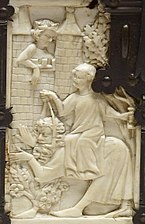
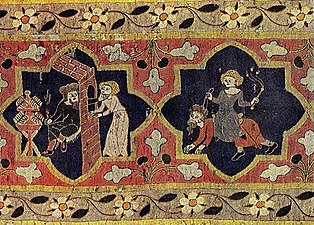

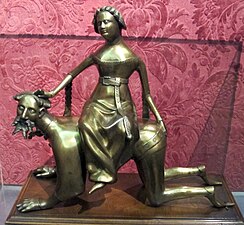

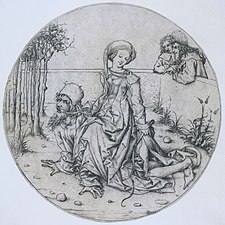



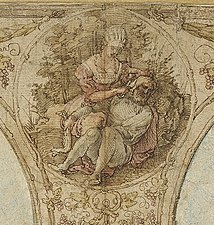

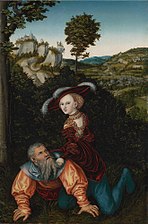


![Le Char (The Chariot), poster by Edward Ancourt [fr] for opera by Émile Pessard, 1878](http://upload.wikimedia.org/wikipedia/commons/thumb/f/fa/Emile_Pessard%2C_Le_Char%2C_002.jpg/277px-Emile_Pessard%2C_Le_Char%2C_002.jpg)
